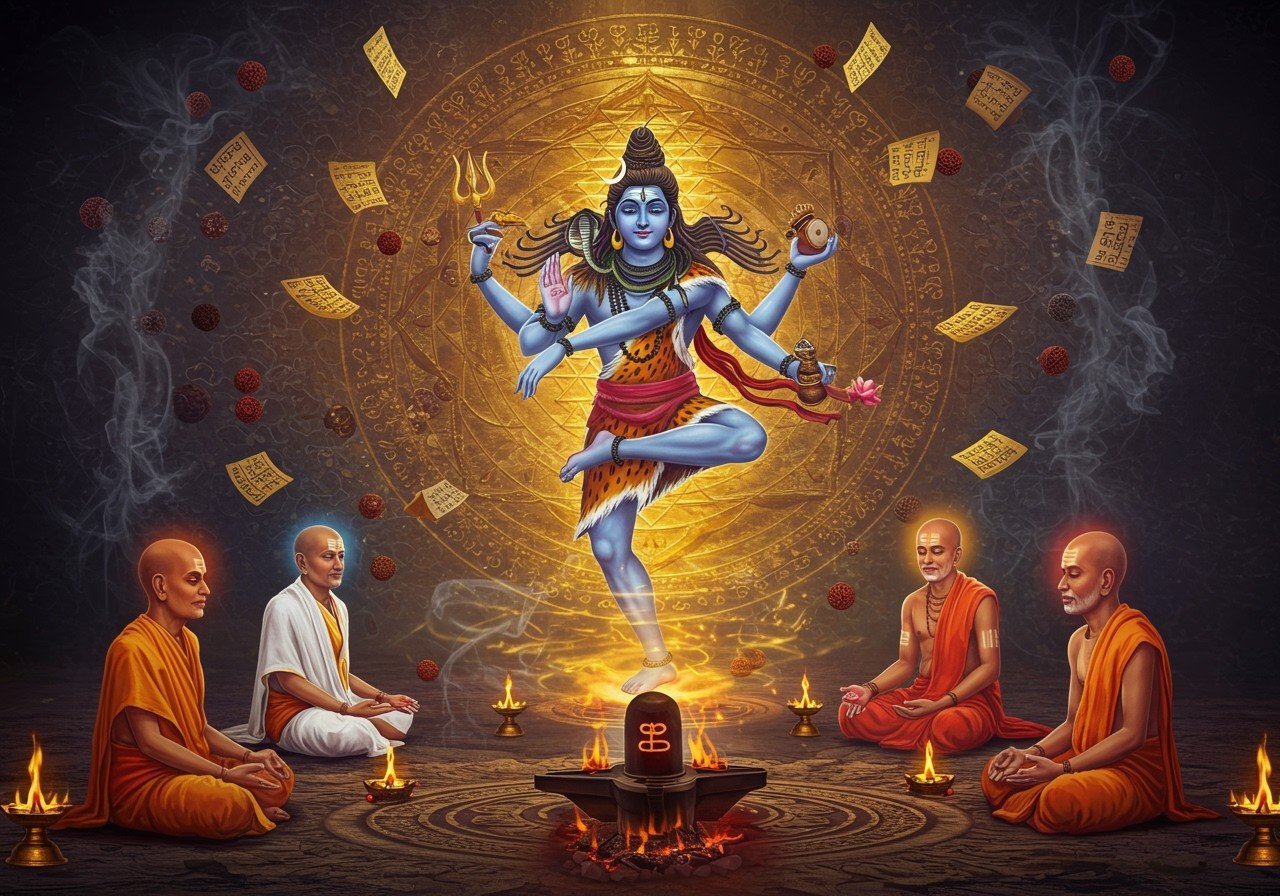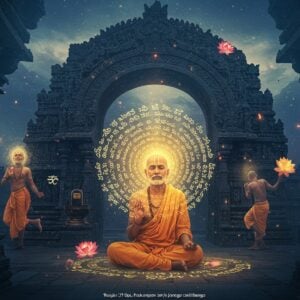
In the rich tapestry of Hindu spiritual traditions, Shaiva Siddhanta shines as a beacon of devotion and philosophical depth. Particularly beloved in Tamil Nadu and Sri Lanka, with influences reaching Vietnam and Indonesia, this school of thought offers a profound path towards understanding our connection with the divine. It’s a journey of the heart, leading us towards union with Lord Shiva.
Delving into the Heart of Shaiva Siddhanta
Shaiva Siddhanta invites us on a devotional path, with the ultimate goal of merging with Shiva. This tradition emphasizes a non-dualistic perspective, highlighting the beautiful interplay between the divine and humanity. It stresses the importance of God’s grace, the guidance of a Guru, and the practical application of spiritual principles in everyday life. At its core, Shaiva Siddhanta recognizes three eternal entities: God (Pati), Soul (Pasu), and the Bonds that hold us back (Pasa). Shiva, the supreme reality, is one, while individual souls are many, bound by the three impurities: Anava (our ego), Karma (the consequences of our actions), and Maya (the illusion that separates us from reality).
Key Concepts: Unlocking the Path to Liberation
The ultimate aim in Shaiva Siddhanta is liberation – not a detachment from existence, but a profound, intimate connection with Shiva, known as bheda-abheda (a state of both separation and non-separation). This liberation is attained through dedicated practice in four key areas: charya (living a virtuous life), kriya (ritual worship), yoga (focused meditation), and jnana (cultivating spiritual knowledge). Let’s explore these key concepts further:
- Pati (The Lord): Shiva is the ultimate source of all creation, preservation, destruction, concealment, and ultimately, grace. He is the cosmic dancer, the benevolent protector, and the force of transformation.
- Pasu (The Individual Soul): Each of us carries a spark of the divine within us, but these individual souls are often veiled by impurities, obscuring our true nature. We are on a journey to unveil that divine spark and realize our connection with Shiva.
- Pasa (The Bonds): These are the impurities—Anava, Karma, and Maya—that bind the soul and keep us trapped in the cycle of birth and death. Shaiva Siddhanta guides us in overcoming these bonds.
Tracing the Roots: History and Sacred Texts
The roots of Shaiva Siddhanta run deep, nourished by the rich soil of Tamil devotional hymns, the Tirumurai, composed by Shaiva saints between the 5th and 9th centuries CE. Tirumular, a revered figure, is considered the founder of Siddhanta, laying down its foundational principles. In the 13th century, Meykandar emerged as the first systematic philosopher of this school, solidifying its place in the philosophical landscape. Shaiva Siddhanta also draws from the Tamil Agamas, sacred scriptures that guide its rituals, cosmology, and theology. You can delve deeper into Hindu philosophy with resources like “Hindu Philosophy Explained: A Beginner’s Guide” and “Hindu Symbols Explained: Their Meanings and Importance” available on poojn.in.
Connections and Contrasts: Shaiva Siddhanta’s Dialogue with Other Philosophies
Shaiva Siddhanta engages in a rich dialogue with other philosophical schools, particularly Vedanta. It embraces the concept of qualified non-duality (bheda-abheda), recognizing the individual soul’s unique relationship with Shiva, while diverging from the pure non-dualism (Advaita) of Advaita Vedanta. To validate its tenets, Shaiva Siddhanta relies on pramanas, valid means of knowledge like perception, inference, and trusted testimony, offering compelling arguments for the existence of God, the soul, and the possibility of liberation. It shares similarities with Sankhya dualism in its triadic ontology of Pati, Pasu, and Pasa, but distinguishes itself by placing Shiva as the supreme, unifying reality.
Embark on a journey of self-discovery with “Connecting With Your Inner Self: A Hindu Philosophy Guide“.
Poojn.in: Your Companion on the Spiritual Path
At poojn.in, we understand the significance of having authentic and readily available resources for your spiritual practices. We offer a wide selection of items to support your Shaiva Siddhanta journey:
- Sacred Murtis: Bring the divine presence into your home with beautifully crafted Adiyogi murtis, Lord Shiva murtis in various sizes and materials, including marble dust and brass. Explore our Maa Lakshmi murtis and Maa Tara murtis for your devotional practices.
- Ritual Essentials: Enhance your puja with pure copper snakes for Shiva lingams and brass Trishuls. We offer a comprehensive range of puja items, from diyas and incense to complete puja thalis, ensuring you have everything you need for a sacred and fulfilling experience.
Visit www.poojn.in or contact us at 03369029784 or via WhatsApp at 9476142738 to explore our collection and enhance your spiritual practice.
Embracing the Journey: Conclusion
Shaiva Siddhanta provides a timeless framework for those seeking a deeper connection with the divine. It beautifully blends devotion, philosophical inquiry, and practical spirituality, guiding us towards a profound relationship with Lord Shiva. Rooted in the rich traditions of Tamil culture, its wisdom transcends geographical boundaries, resonating with seekers across diverse cultures and generations. Whether you’re steeped in tradition or just beginning your spiritual exploration, Shaiva Siddhanta offers a welcoming and illuminating path. As we delve into its teachings, we discover not just a path to liberation, but a way to live with grace, purpose, and a deep understanding of our place in the cosmos.
Frequently Asked Questions about Shaiva Siddhanta
What is Shaiva Siddhanta’s place within Shaivism? Shaiva Siddhanta is a core philosophical doctrine within Shaivism, providing a framework for understanding the nature of reality and our relationship with the divine.
How does Shaiva Siddhanta explain the connection between the individual and the divine? It emphasizes the concept of bheda-abheda, a state of both separation and non-separation, highlighting the individual soul’s unique connection with Shiva.
What are the central tenets of Shaiva Siddhanta? It revolves around the three eternal entities of Pati (God/Shiva), Pasu (individual soul), and Pasa (bondage/impurities). Liberation is achieved through charya, kriya, yoga, and jnana.
Why is Shaiva Siddhanta important for spiritual seekers? It offers a comprehensive path towards spiritual growth and liberation, integrating devotion, philosophical understanding, and practical spiritual practices. It empowers individuals to deepen their connection with Shiva and understand their true nature.
How does one integrate Shaiva Siddhanta into daily life? The principles of charya, kriya, yoga, and jnana can be incorporated into daily routines through ethical conduct, ritual worship, meditation, and the pursuit of spiritual knowledge.
Which texts offer deeper insights into Shaiva Siddhanta? The Tirumurai, a collection of Tamil devotional hymns, is a cornerstone of this tradition. Other important texts include the Agamas, which detail rituals and theological concepts.
Is Shaiva Siddhanta accessible to everyone? Absolutely. Whether you’re a seasoned practitioner or new to Shaivism, its teachings offer profound wisdom and guidance for anyone seeking a deeper understanding of themselves and the divine.
How does Shaiva Siddhanta differ from other Shaivite doctrines? While sharing common ground with other Shaivite traditions, Shaiva Siddhanta distinguishes itself through its emphasis on qualified non-dualism (bheda-abheda), its unique interpretation of the Pati-Pasu-Pasa triad, and its reliance on Tamil scriptures and saints.


